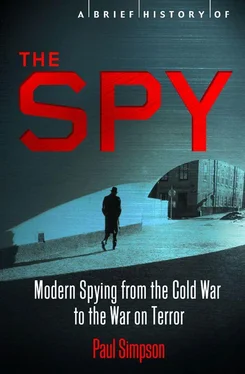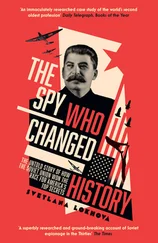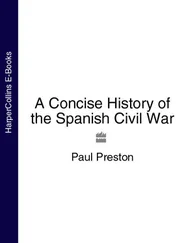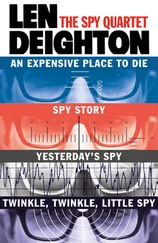Paul Simpson - A Brief History of the Spy
Здесь есть возможность читать онлайн «Paul Simpson - A Brief History of the Spy» весь текст электронной книги совершенно бесплатно (целиком полную версию без сокращений). В некоторых случаях можно слушать аудио, скачать через торрент в формате fb2 и присутствует краткое содержание. Город: London, Год выпуска: 2013, ISBN: 2013, Издательство: Constable & Robinson, Жанр: Прочая документальная литература, на английском языке. Описание произведения, (предисловие) а так же отзывы посетителей доступны на портале библиотеки ЛибКат.
- Название:A Brief History of the Spy
- Автор:
- Издательство:Constable & Robinson
- Жанр:
- Год:2013
- Город:London
- ISBN:9781780338910
- Рейтинг книги:3 / 5. Голосов: 1
-
Избранное:Добавить в избранное
- Отзывы:
-
Ваша оценка:
- 60
- 1
- 2
- 3
- 4
- 5
A Brief History of the Spy: краткое содержание, описание и аннотация
Предлагаем к чтению аннотацию, описание, краткое содержание или предисловие (зависит от того, что написал сам автор книги «A Brief History of the Spy»). Если вы не нашли необходимую информацию о книге — напишите в комментариях, мы постараемся отыскать её.
A Brief History of the Spy — читать онлайн бесплатно полную книгу (весь текст) целиком
Ниже представлен текст книги, разбитый по страницам. Система сохранения места последней прочитанной страницы, позволяет с удобством читать онлайн бесплатно книгу «A Brief History of the Spy», без необходимости каждый раз заново искать на чём Вы остановились. Поставьте закладку, и сможете в любой момент перейти на страницу, на которой закончили чтение.
Интервал:
Закладка:
Goleniewski’s testimony would also be responsible for the downfall of Heinz Felfe within the BND; he was arrested in October 1961 and eventually sentenced to fifteen years’ hard labour. Felfe’s legacy, though, was that much of the West German counter-intelligence work over the previous decade had to be deemed suspect, injuring Reinhard Gehlen’s hard-won reputation for backing his own judgement.
The defector himself started to lose some credibility when he began to maintain that he was the Tsarevich Alexei Nikolaevich, who most believe had been killed with the rest of the Russian royal family in 1917 at Ekaterinburg. Goleniewski claimed that he gave his date of birth as 1922 to explain why he looked so young (the Tsarevich was born in 1904) since he suffered from haemophilia. Unsurprisingly, the CIA released him from its payroll in 1964, a year after he started making these claims publicly.
While the KGB were losing agents, the CIA was apparently going from strength to strength. The death of Congolese leader Patrice Lumumba in January 1961 certainly came at a convenient time for the Agency, even if they were not finally responsible for his demise. Lumumba was the first prime minister of the independent Republic of Congo after it gained independence from Belgium, but the tumultuous nature of his administration, and the civil war that quickly broke out there, gave rise to panic in Washington. CIA director Allen Dulles noted that ‘We are faced with a person who is a Castro or worse. Lumumba has been bought by the Communists,’ and in a memo wrote, ‘In high quarters here, it is the clear-cut conclusion that if [Lumumba] continues to hold high office, the inevitable result will [have] disastrous consequences… for the interests of the free world generally. Consequently, we conclude that his removal must be an urgent and prime objective.’
While the CIA were supporting Joseph Mobutu’s faction in the civil war, enter MKULTRA’s chief scientist, Dr Sidney Gottlieb, who was sent to Leopoldville with a plan to arrange for Lumumba’s assassination with poisoned toothpaste. The CIA station chief, Lawrence Devlin, claimed that he refused to carry out the instructions and that after Lumumba was arrested by opposing forces in December, he threw the poison into the Congo River. Some declassified documents suggest that CIA agents assisted with the disposal of Lumumba’s body after his execution on 17 January 1961 — his corpse was certainly never found — but Devlin would later deny any CIA involvement, even after the Belgians admitted their role.
The early part of the sixties would be dominated by the relationship between incoming US President John F. Kennedy and his Soviet counterpart, Nikita Khruschev, with the world coming closer to war during that period than at any time since 1945. Although Russian and American tanks would come face-to-face at Checkpoint Charlie in Berlin for a perilous sixteen hours on 22 October 1961, shortly after the construction of the wall dividing East and West Berlin, the real flashpoint was Cuba.
The problem there had begun when Fidel Castro took power in the Caribbean island country in 1959. Castro seemed to be an improvement on the previous leader, dictator Fulgencio Batista. He tried to reassure Americans of his good intentions: ‘I know what the world thinks of us, we are Communists, and of course I have said very clearly that we are not Communists; very clearly.’ However, it quickly became clear that he would very easily become a thorn in America’s side, particularly given how close the country was to US shores.
The KGB began dealings with Castro’s chief of intelligence as early as July 1959, sending over a hundred advisers to help overhaul the security and intelligence services, and later that year, Castro began to nationalize American plantations as well as close down lucrative concessions run by the Mafia. In March 1960, President Eisenhower approved a programme of action against the Cuban government, its stated purpose was to ‘bring about the replacement of the Castro regime with one more devoted to the true interests of the Cuban people and more acceptable to the US in such a manner to avoid any appearance of US intervention’. Anti-Castro Cubans who had fled to Florida were recruited for the cause and started to undergo training.
The Soviet leadership began to publicly support Castro: ‘We shall do everything to support Cuba in her struggle,’ Khrushchev proclaimed in July 1960, adding ominously, ‘Now the United States is not so unreachable as she once was.’ Suspecting that Americans could be thrown off the island shortly, three CIA technical officers were sent into Cuba in August to put surveillance devices into an enemy embassy, but when that proved impossible they were captured during their attempt to bug the New China News Agency. They would stay in Cuban jails throughout the dramatic events of the next three years.
John F. Kennedy succeeded Eisenhower in January 1961. The incoming president was informed of the plot against Castro, and the plan to promote regime change in Cuba. The briefing suggested ‘Moscow had put in place a puppet ruler who… promoted dissent in Nicaragua, Haiti, Panama and the Dominican Republic in order to surround the southern United States with Communist satellites.’ Buoyed by their previous successful regime changes in Iran and Guatemala, the CIA intended to land their trained exiles near Trinidad in southern Cuba, close to anti-Castro groups, and set off an uprising.
The new president wasn’t so keen. Kennedy did not want his term of office to begin with an American-sponsored invasion, and he insisted that the exiles land at the Bay of Pigs, a hundred miles from their original target. He also scaled back the air support that the CIA intended to provide, removing the initial air strike, and postponing the second until after it was clear the invasion had succeeded. CIA Deputy Director Richard Bissell felt this would seriously jeopardize the outcome, but his hands were tied.
Launched on 17 April 1961, the invasion was a catastrophic failure, with hundreds of the Cuban exiles killed or captured, and thousands on both sides injured. Kennedy took full responsibility publically: ‘There’s an old saying that victory has a hundred fathers and defeat is an orphan… What matters is only one fact, I am the responsible officer of the government.’ Behind the scenes, he accepted Allen Dulles’ resignation as DCI of the CIA, and Richard Bissell resigned after he was demoted. An internal CIA report castigated the Agency for ‘exceed[ing] its capabilities in developing the project from guerrilla support to overt armed action without any plausible deniability’ and its ‘failure to realistically assess risks and to adequately communicate information and decisions internally and with other government principals.’
This didn’t mean that the US government’s desire to see Castro removed from power disappeared, and in November 1961, Kennedy approved Operation Mongoose, whose aim was to ‘help Cuba overthrow the Communist regime’, through ‘a revolt which can take place in Cuba by October 1962’. This was masterminded by the administration’s Attorney-General, Kennedy’s brother Robert.
Over the next few years, assorted plans to assassinate Fidel Castro were drawn up by the CIA, many of these focusing on the dictator’s trademark cigars. At different times, they considered lacing them with hallucinogenic drugs, poisons, depilatory chemicals and even explosives! To cover their tracks, the agency contemplated an alliance with the Mafia: documents declassified in 2007 recount meetings between a CIA go-between, Robert Maheu, and mob bosses Momo Salvatore Giancana and Santos Trafficante, with Giancana suggesting that ‘some type of potent pill that could be placed in Castro’s food or drink would be much more effective’.
Читать дальшеИнтервал:
Закладка:
Похожие книги на «A Brief History of the Spy»
Представляем Вашему вниманию похожие книги на «A Brief History of the Spy» списком для выбора. Мы отобрали схожую по названию и смыслу литературу в надежде предоставить читателям больше вариантов отыскать новые, интересные, ещё непрочитанные произведения.
Обсуждение, отзывы о книге «A Brief History of the Spy» и просто собственные мнения читателей. Оставьте ваши комментарии, напишите, что Вы думаете о произведении, его смысле или главных героях. Укажите что конкретно понравилось, а что нет, и почему Вы так считаете.












